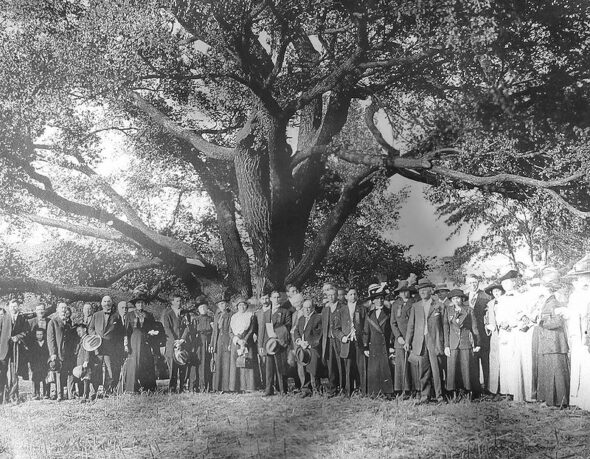
The Logan Elm in 1912, when the tree was memorialized as the location of “Logan’s Lament,” a famed speech delivered by Chief Logan of the Mingo tribe. (Photo courtesy of the Scioto Historical Collection, Shawnee State University)
In the shadow of giants
- Published: October 16, 2025
By Don Cipollini
No one would accuse me of not seeing the forest for the trees, but I am known to cross state lines just to see a single majestic tree.
Large and old trees are a testament to resilience when you consider the numerous environmental, cultural and social challenges they’ve had to endure to remain standing. Escaping the logger’s axe is paramount to their existence, and that is often aided by the tree having the good fortune of living in a protected area or otherwise having a story.
Ohio’s forest cover was reduced from 95% to 15% of the state at one point — it’s around 35% now — yet Ohio has been home to many trees of dramatic proportions, and the best of them come with stories, too. Some of these still stand, while others are part of history, but seeing them — even if only in pictures — and learning their backstory is inspiring.
Such is the case for the Logan Elm. This tree was an American elm — Ulmus americana — located in Pickaway County south of Circleville in an area known as the Pickaway Plains.
At its peak, the Logan Elm was around 100 feet tall and 24 feet in circumference with a 180-foot canopy spread. The shade cast by this tree would have covered two-thirds of an acre and it was considered one of the largest elms in the nation at one point.
The Logan Elm was “born” in around 1700 and was so named because Chief Logan of the Mingo people was said to have delivered his famous speech “Logan’s Lament” under this tree in the fall of 1774. This speech was delivered to an interpreter in response to forced peace negotiations between Indians of the Ohio country and European colonists led by Lord Dunmore of Virginia. In it, Chief Logan lamented the fact that, while he had been a generous and forgiving friend to the white man, members of his family were surreptitiously slaughtered in the Yellow Creek Massacre that occurred in eastern Ohio along the Ohio River. It described how he took his revenge with no regrets, and while he welcomed peace, it was not because he was afraid of the consequences of not doing so. This speech was so impactful that Thomas Jefferson included it in his book, “Notes on the State of Virginia,” in 1784, exposing Logan’s words to a wide audience.
The Logan Elm reached its apex in the mid-1900s, and historical photos depict gatherings of all sorts held under this massive tree and on the grounds nearby. When Logan spoke his famous words, the tree would have been 75 years old and, while likely still impressive, of much more modest size. But the simple fact that he spoke those words under this tree led it to be revered and protected, officially so in 1912.
Unfortunately, the Logan Elm eventually succumbed to the scourge of many an elm in North America, Dutch Elm Disease, which reached the United States in the 1930s. This disease is caused by a fungal pathogen that is moved around primarily by elm bark beetles. Elms can reach fairly large sizes before they get attacked, which has ensured their continued presence on the landscape, but once they do, their fate is sealed. Storm damage struck the final blow to the Logan Elm in 1964 when the tree was already in decline.
While the Logan Elm is no longer present, its legacy lives on in several ways. First, there was a program to take cuttings from the tree from 1920 to 1940, grow them in Scioto State Forest and then offer saplings to all of the counties in Ohio that would have them. Trees found their way to locations such as the Governor’s Mansion in Columbus and other similar locations. Locally, one such offspring is located on the campus of Wilmington College next to College Hall, the oldest building on campus. It was received by the school in 1935 and, at present, it is 65 feet tall and 12 feet in circumference with a 120-foot canopy spread. Since it was taken as a branch cutting directly from the Logan Elm and rooted, it is not only an offspring of the Logan Elm, it is the Logan Elm in genetic terms. Standing under it gives you a sense of the majesty of the original Logan Elm, albeit on a smaller scale. It is also completely free of Dutch Elm Disease despite not being treated for it, but it would be susceptible with sufficient exposure to this fungal pathogen given the fate of its parent.
Second, when the Logan Elm was taken down in 1964, parts of the tree were preserved and distributed to willing takers. The best display of these artifacts is located in the eponymous Logan Elm High School east of Circleville, where a display case near the gymnasium holds a cross section of a large branch of the Logan Elm along with artwork and historical accounts of Chief Logan and the tree. Lastly, the site where the Logan Elm stood in the Pickaway Plains has been preserved as the Logan Elm State Memorial. A few large American elms stand in the park — among the monuments to Chief Logan and other participants in the saga — and one wonders whether they, too, are offspring of the Logan Elm.
Standing under one of them at this site on a misty October day, as I have done, gives you a sense of what Chief Logan was feeling in 1774 when he delivered his famous lament.
*Yellow Springs resident Don Cipollini, Ph.D., is director of environmental sciences and a professor of biological sciences at Wright State University.
The Yellow Springs News encourages respectful discussion of this article.
You must login to post a comment.
Don't have a login? Register for a free YSNews.com account.















No comments yet for this article.